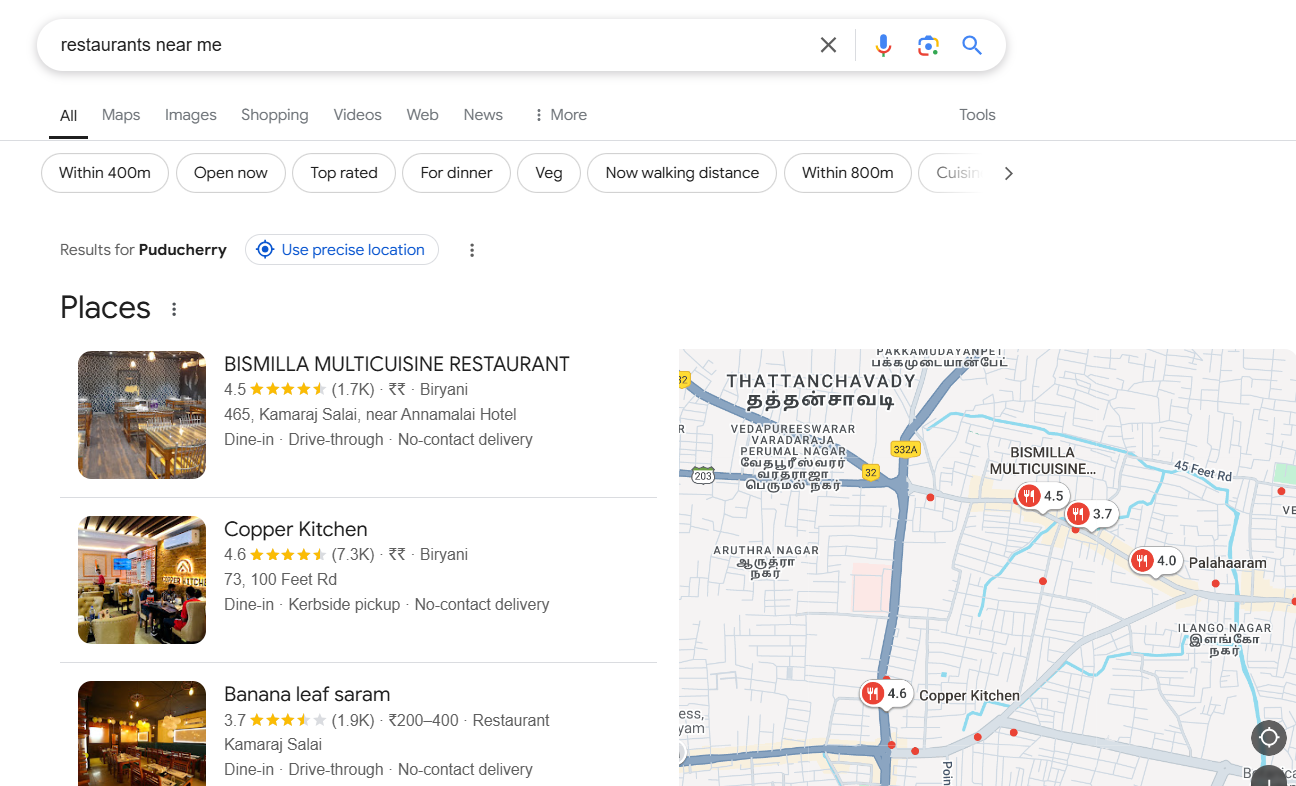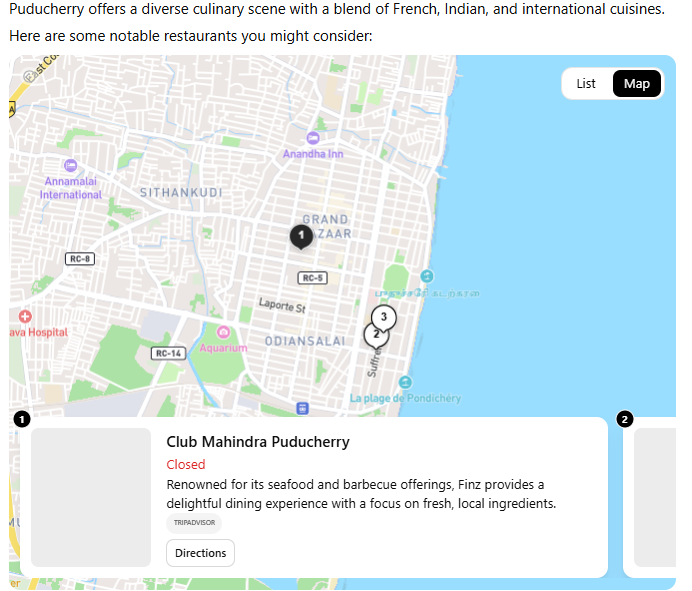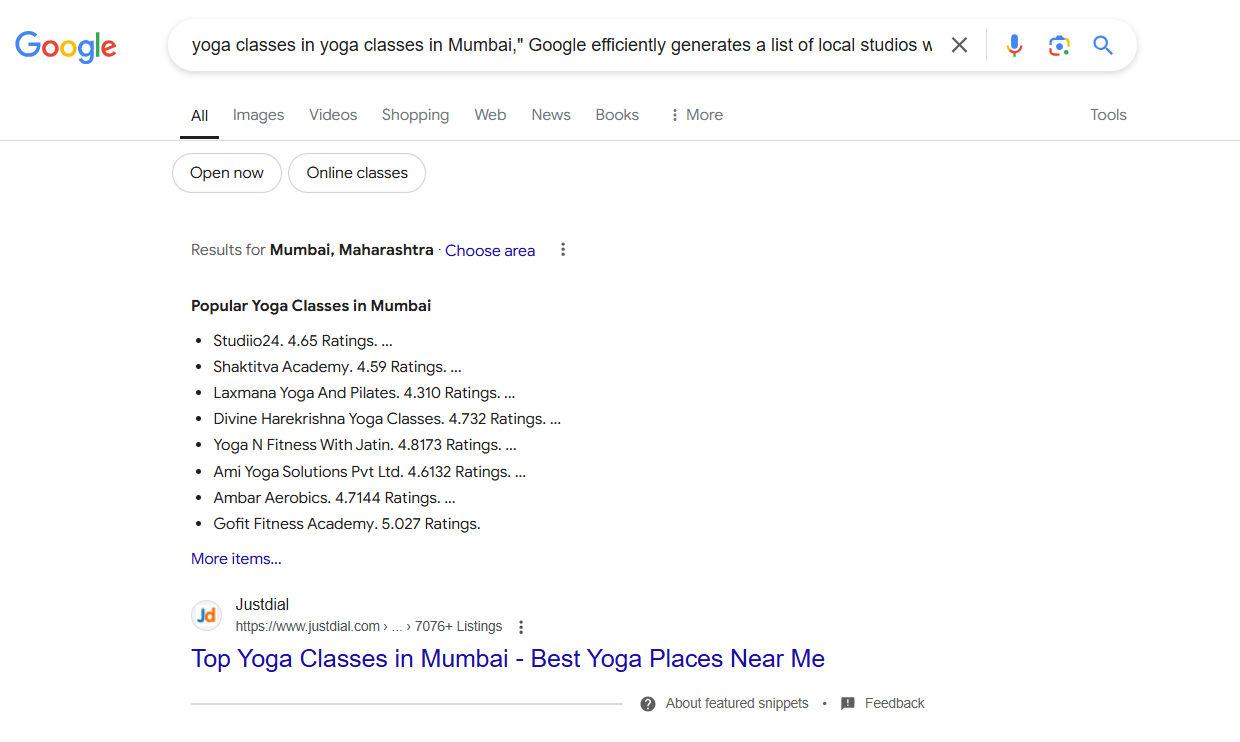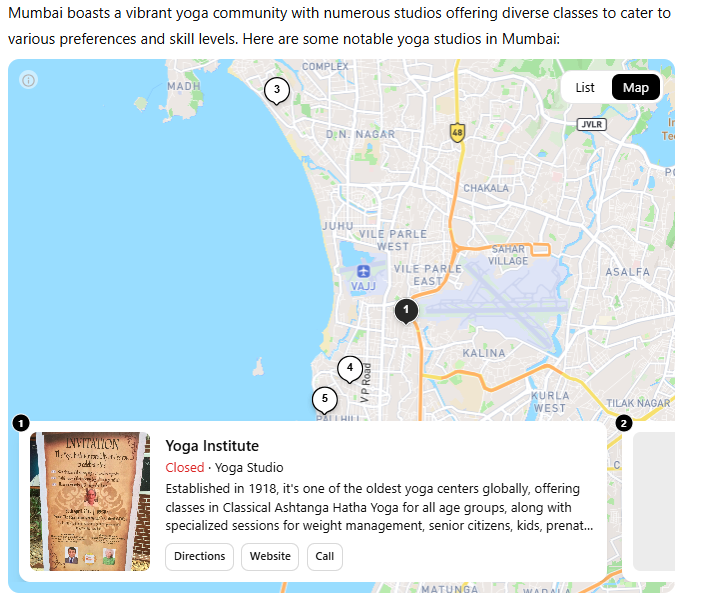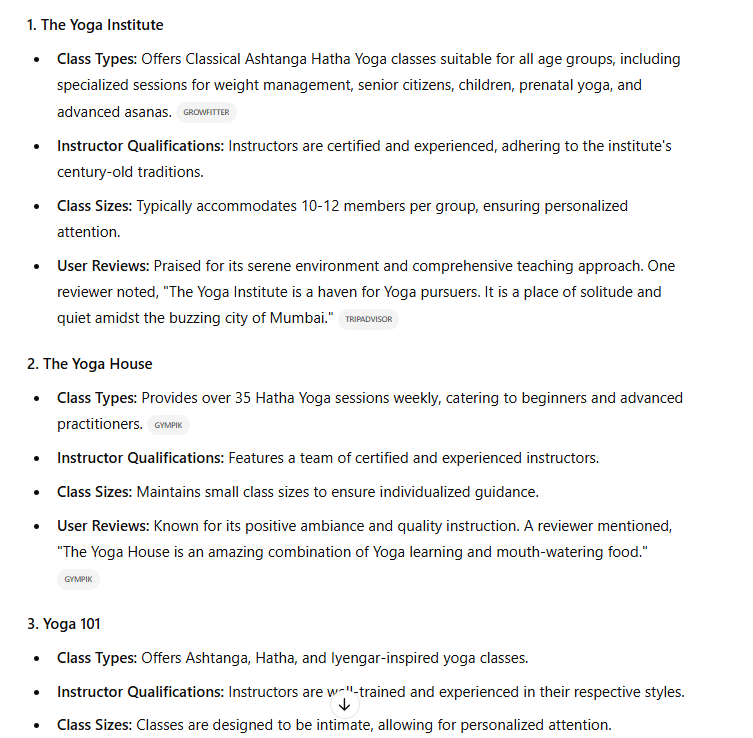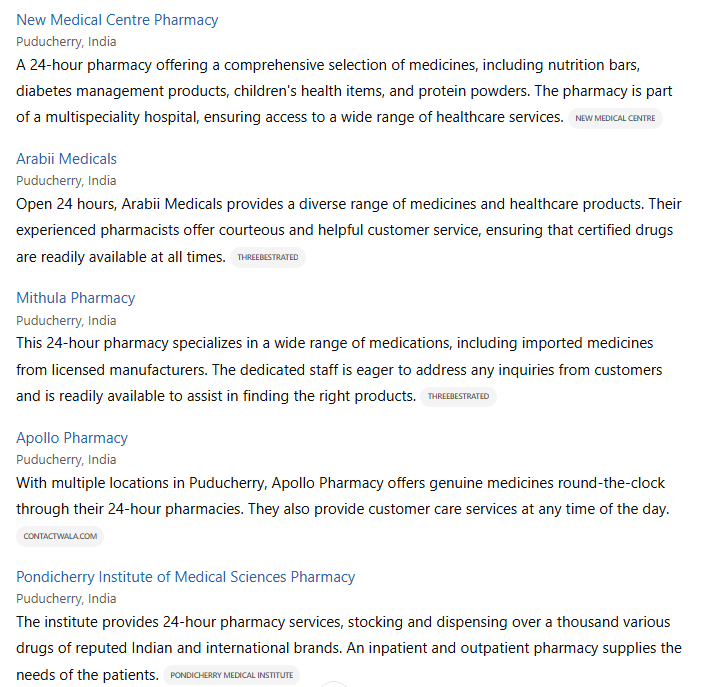Introduction
Search engines are constantly evolving due to technological advancements and shifting user preferences. Traditionally dominated by Google, the search engine market is now witnessing the emergence of AI-driven platforms like SearchGPT.
Understanding the differences in search capabilities between these two systems is essential for users and businesses, as it influences how information is accessed and utilised.
In this comparison, we will explore local intent searches—queries where users seek information relevant to their immediate geographic location—and how each platform addresses these needs.
Overview of Google’s Local Intent Search
Google has long been recognised for its powerful search capabilities, and its approach to local intent searches is particularly robust. When users perform a local search, they are often met with a seamless interface that quickly delivers relevant results. Features such as the local pack, which includes maps, user reviews, and contact details, streamline the process, enabling users to find what they need with minimal effort.
For example, searching for “restaurants near me” on Google will yield a list of nearby dining options, complete with ratings, hours of operation, and directions. Integrating user-generated content, such as reviews and photos, further enhances the search experience, making it easier for users to make informed decisions.
In practice, Google’s capabilities mean searching for a “plumber in Pune” will return specific local listings, allowing users to connect with relevant service providers quickly.
Overview of SearchGPT’s Local Intent Search
SearchGPT, as a newer entry in the search landscape, leverages the power of AI and natural language processing (NLP) to respond to local intent queries. Unlike traditional search engines, SearchGPT focuses on understanding the user’s intent and providing context-aware responses rather than just returning a list of links.
For example, if a user asks SearchGPT for “restaurants near me,” the AI might provide a conversational response that includes popular dining options and suggestions based on cuisine preferences. This approach can be beneficial for users seeking more personalised recommendations.
What sets SearchGPT apart is its ability to engage users in a dialogue, allowing for follow-up questions and clarifications. This context-rich interaction adds depth to the user experience, particularly when exploring local options.
Comparative Analysis Examples
“Near Me” Searches
Google’s Approach
When a user searches for “restaurants near me,” Google quickly generates a list of nearby dining options, complete with ratings, reviews, and integrated maps. The streamlined interface allows users to access the information they need with minimal effort.
Strengths
- Immediate Access: Google delivers relevant results without delay, helping users find options quickly.
- Integrated Maps: Including maps and contact information enhances usability, enabling users to navigate directly to their chosen restaurant.
Weaknesses
- Limited Context: While Google provides quick results, it often lacks deeper contextual information about the establishments listed.
SearchGPT’s Approach
In contrast, SearchGPT might respond to a query like “restaurants near me” with a list of nearby dining options enriched with additional context, such as popular dishes, special promotions, or user reviews. This approach can enhance the user experience but may take longer to deliver results.
Search GPT offers a diverse culinary scene, blending French, Indian, and international flavours. Here are some notable dining options, along with their popular dishes, special promotions, and user reviews:
These establishments offer a glimpse into Puducherry’s rich culinary landscape, each providing unique flavours and dining experiences.
Strengths
- Enriched Context: SearchGPT offers valuable context and recommendations, which can aid users in making informed decisions.
- Conversational Engagement: The interactive nature of SearchGPT fosters engagement, allowing users to ask follow-up questions.
Weaknesses
- Slower Response Time: The added context may lead to a longer wait for results, which might frustrate users looking for immediate answers.
- Limited Listings: SearchGPT may not provide as comprehensive local listings as Google.
Service-Specific Local Searches
Google’s Approach
For a search like “yoga classes in Mumbai,” Google efficiently generates a list of local studios with ratings and links to their websites. Users can quickly find relevant information and decide based on the presented data.
Strengths
- Efficient Delivery: Google provides relevant information quickly, ensuring high visibility for local businesses.
- User-Friendly: The straightforward interface makes navigating and locating services easy for users.
Weaknesses
- Limited Insights: While Google is efficient, it often lacks deeper contextual insights about the services offered, which could help users make better-informed choices.
SearchGPT’s Approach
SearchGPT would likely respond to “yoga classes in Mumbai” by listing local studios and providing insights into class types, instructor backgrounds, and user reviews.
Here is a sample of how search GPT gives an overview of some notable studios, highlighting their class types, instructor qualifications, class sizes, and user reviews
Strengths
- Richer Context: This approach enhances user understanding and allows for more personalised recommendations based on preferences.
- Engagement: The conversational format encourages users to explore and ask additional questions.
Weaknesses
Less Immediate Results: Users may experience delays in receiving direct answers, which can be a drawback for those seeking quick information.
Incompleteness: The coverage of local options may not be as extensive as Google’s, limiting the user’s choices.
“Open Now” Searches
Google’s Approach
When users search for “pharmacy open now near me,” Google quickly identifies local pharmacies currently open, providing direct links and contact details. This quick access to real-time information is crucial for users needing immediate services.
Strengths
- Fast Access: Google facilitates quick navigation to essential services, enhancing user satisfaction.
- Real-Time Updates: The ability to show current operating hours is a significant advantage for users.
Weaknesses
- Surface-Level Information: Users may receive less in-depth information about the services offered at these pharmacies.
SearchGPT’s Approach
SearchGPT would likely provide a list of open pharmacies while including contextual information about services offered, such as flu shots or health consultations.
Strengths
- Contextual Insights: Providing additional details can aid users in decision-making, particularly for those unfamiliar with the services.
- Conversational Responses: The approach engages users, making the search experience more interactive.
Weaknesses
- Slower Presentation: The time taken to deliver detailed responses may deter users looking for immediate results.
- Limited Local Data: SearchGPT’s access to real-time local business data can be restricted compared to Google’s extensive database.
Comparison summary
The comparative analysis reveals that Google excels in efficiency and speed, making it the preferred choice for straightforward local intent searches. Its ability to provide immediate results and integrate real-time data significantly enhances user satisfaction. However, it often lacks the depth of context that some users may seek.
On the other hand, SearchGPT adds value through its contextual and personalised approach. While it may take longer to deliver results, the enriched information can lead to a more informed and engaging user experience. The choice between Google and SearchGPT often hinges on whether users prioritise speed or the depth of information in their search results.
Implications for SEO Strategies
Understanding the strengths and weaknesses of both Google and SearchGPT is crucial for SEO specialists and local businesses. Optimising for Google involves ensuring content is easily discoverable, relevant, and quick-loading, catering to users who prioritise immediate results. This can include utilising local SEO best practices, such as optimising Google My Business listings and incorporating local keywords.
In contrast, leveraging SearchGPT’s capabilities requires creating content that provides depth and context. This means developing rich, informative content that addresses user queries comprehensively and encourages engagement. Businesses can benefit from creating FAQs, guides, and detailed service descriptions that enhance the user experience.
Key Differences in User Experience and Implications for SEO Strategies
The comparative analysis reveals distinct differences in user experience between Google and SearchGPT.
| SearchGPT | |
| Efficiency: Google’s strength lies in its speed and quick navigation, making it ideal for users prioritising immediate results and ease of access. | Contextual Depth: SearchGPT excels at providing context and depth, catering to users seeking more than just a direct link and enhancing the overall search experience. |
| Straightforward Results: It is the go-to choice for straightforward local searches with clear objectives, quickly delivering relevant information. | Engaging Interaction: SearchGPT’s conversational approach encourages users to engage more deeply with the content, allowing follow-up questions and personalised responses. |
| Data Integration: Google offers extensive integration of various data types (maps, reviews, images), ensuring comprehensive local listings that facilitate quick decision-making. | Personalised Recommendations: SearchGPT can provide tailored suggestions based on user queries, preferences, and past interactions, fostering a more customised experience. |
| User-Centric Interface: Google’s clean and intuitive interface allows users to navigate easily, even if unfamiliar with the platform. | Interactive Experience: SearchGPT’s interface is more interactive and designed to simulate human conversation, which can make users feel more engaged and supported. |
| Real-Time Updates: Google provides real-time information about business hours, availability, and services, which is crucial for users who need immediate assistance. | Rich Content Delivery: SearchGPT can deliver richer content, including tips, FAQs, and detailed explanations, which can be particularly useful for users unfamiliar with a service. |
| SEO Focus: Optimizing for Google involves ensuring content is easily discoverable through local SEO practices, such as proper keyword usage, local listings, and schema markup. | Content Strategy: Leveraging SearchGPT’s capabilities requires creating in-depth content that answers user queries comprehensively and enhances user engagement through storytelling and informative articles. |
| Broad Audience Reach: Google’s established dominance means that it has a wide audience, making it essential for businesses to be visible on this platform to reach potential customers effectively. | Niche Engagement: SearchGPT’s unique approach may appeal to specific user segments looking for conversational and context-rich interactions, allowing businesses to target audiences seeking depth rather than quick answers. |
| Algorithm Adaptability: Google’s algorithms are continuously updated to improve user experience, necessitating constant monitoring and adaptation of SEO strategies to align with changes. | AI Learning Curve: SearchGPT’s AI relies on user interactions to improve its responses over time, suggesting that businesses may need to adapt content based on how users engage with and respond to it. |
Understanding these differences is essential for SEO specialists and local business owners.
- Optimising for Google: To align with Google’s strengths, businesses should focus on:
- Local SEO Best Practices: Ensuring business listings are complete and accurate across various platforms (e.g., Google My Business).
- Keyword Optimisation: Using relevant local keywords that potential customers might search for.
- Mobile Optimization: Ensuring websites are mobile-friendly, as many local searches are conducted on mobile devices.
- Structured Data: Implementing schema markup to improve visibility in local search results.
- Leveraging SearchGPT: To take advantage of SearchGPT’s capabilities, businesses should:
- Create In-Depth Content: Develop content that answers common questions about their services, providing detailed insights that enhance user understanding.
- Engage Users: Utilize storytelling techniques and interactive content that invites users to explore further and ask questions.
- Monitor User Feedback: Pay attention to how users interact with content to refine and improve responses based on engagement metrics.
- Personalisation: Consider implementing AI tools to provide personalised recommendations and responses based on user behaviour.
Future Predictions for Local Intent Search Technology
The technology behind local intent searches is continually evolving and is driven by AI and machine learning advancements. Future developments promise even greater integration of natural language processing and context-aware responses, enhancing the accuracy and relevance of search results.
Emerging trends indicate a move toward increased personalisation, with search engines tailoring results based on user behaviour and preferences. This evolution will benefit both Google and SearchGPT as they adapt their approaches to meet individual user needs.
The growth of voice-activated search and AI-driven assistants will further shape the local search landscape, creating a more seamless and intuitive user experience.
Conclusion
Local intent search is a critical aspect of the digital experience, enhancing user satisfaction by guiding individuals directly to their desired services and businesses. Our comparison of Google and SearchGPT highlights their unique strengths and approaches, offering valuable insights for SEO specialists and local businesses.
Google’s speed and efficiency make it a reliable choice for straightforward local searches, while SearchGPT’s context-rich responses foster deeper engagement. Both platforms provide distinct advantages, allowing users to choose based on their priorities.
For those in the digital marketing space, mastering local intent search involves understanding these differences and adapting strategies accordingly. By leveraging the strengths of both Google and SearchGPT, businesses can enhance their visibility and user experience.
To explore these platforms further, experiment with Google and SearchGPT to find which best fits your needs. Stay informed and adaptable as local search technology continues to evolve.
Mastering the Future of Search and Marketing
upGrowth is your trusted partner for sustainable business growth, specialising in innovative marketing strategies tailored to your unique needs. Our team combines data-driven insights with creative solutions to enhance customer acquisition, optimise digital presence, and drive measurable results. Whether you’re looking to launch a new product, boost organic traffic, or leverage social media, upGrowth provides the expertise and tools necessary to navigate the evolving digital landscape. Join us to unlock your business’s full potential and achieve lasting success in today’s competitive market.
Comparative Analysis Examples
“Near Me” Searches
Google’s Approach
When a user searches for “restaurants near me,” Google quickly generates a list of nearby dining options, complete with ratings, reviews, and integrated maps. The streamlined interface allows users to access the information they need with minimal effort.
Strengths
- Immediate Access: Google delivers relevant results without delay, helping users find options quickly.
- Integrated Maps: Including maps and contact information enhances usability, enabling users to navigate directly to their chosen restaurant.
Weaknesses
- Limited Context: While Google provides quick results, it often lacks deeper contextual information about the establishments listed.
SearchGPT’s Approach
In contrast, SearchGPT might respond to a query like “restaurants near me” with a list of nearby dining options enriched with additional context, such as popular dishes, special promotions, or user reviews. This approach can enhance the user experience but may take longer to deliver results.
Search GPT offers a diverse culinary scene, blending French, Indian, and international flavours. Here are some notable dining options, along with their popular dishes, special promotions, and user reviews:
These establishments offer a glimpse into Puducherry’s rich culinary landscape, each providing unique flavours and dining experiences.
Strengths
- Enriched Context: SearchGPT offers valuable context and recommendations, which can aid users in making informed decisions.
- Conversational Engagement: The interactive nature of SearchGPT fosters engagement, allowing users to ask follow-up questions.
Weaknesses
- Slower Response Time: The added context may lead to a longer wait for results, which might frustrate users looking for immediate answers.
- Limited Listings: SearchGPT may not provide as comprehensive local listings as Google.
Service-Specific Local Searches
Google’s Approach
For a search like “yoga classes in Mumbai,” Google efficiently generates a list of local studios with ratings and links to their websites. Users can quickly find relevant information and decide based on the presented data.
Strengths
- Efficient Delivery: Google provides relevant information quickly, ensuring high visibility for local businesses.
- User-Friendly: The straightforward interface makes navigating and locating services easy for users.
Weaknesses
- Limited Insights: While Google is efficient, it often lacks deeper contextual insights about the services offered, which could help users make better-informed choices.
SearchGPT’s Approach
SearchGPT would likely respond to “yoga classes in Mumbai” by listing local studios and providing insights into class types, instructor backgrounds, and user reviews.
Here is a sample of how search GPT gives an overview of some notable studios, highlighting their class types, instructor qualifications, class sizes, and user reviews
Strengths
- Richer Context: This approach enhances user understanding and allows for more personalised recommendations based on preferences.
- Engagement: The conversational format encourages users to explore and ask additional questions.
Weaknesses
Less Immediate Results: Users may experience delays in receiving direct answers, which can be a drawback for those seeking quick information.
Incompleteness: The coverage of local options may not be as extensive as Google’s, limiting the user’s choices.
“Open Now” Searches
Google’s Approach
When users search for “pharmacy open now near me,” Google quickly identifies local pharmacies currently open, providing direct links and contact details. This quick access to real-time information is crucial for users needing immediate services.
Strengths
- Fast Access: Google facilitates quick navigation to essential services, enhancing user satisfaction.
- Real-Time Updates: The ability to show current operating hours is a significant advantage for users.
Weaknesses
- Surface-Level Information: Users may receive less in-depth information about the services offered at these pharmacies.
SearchGPT’s Approach
SearchGPT would likely provide a list of open pharmacies while including contextual information about services offered, such as flu shots or health consultations.
Strengths
- Contextual Insights: Providing additional details can aid users in decision-making, particularly for those unfamiliar with the services.
- Conversational Responses: The approach engages users, making the search experience more interactive.
Weaknesses
- Slower Presentation: The time taken to deliver detailed responses may deter users looking for immediate results.
- Limited Local Data: SearchGPT’s access to real-time local business data can be restricted compared to Google’s extensive database.
Comparison summary
The comparative analysis reveals that Google excels in efficiency and speed, making it the preferred choice for straightforward local intent searches. Its ability to provide immediate results and integrate real-time data significantly enhances user satisfaction. However, it often lacks the depth of context that some users may seek.
On the other hand, SearchGPT adds value through its contextual and personalised approach. While it may take longer to deliver results, the enriched information can lead to a more informed and engaging user experience. The choice between Google and SearchGPT often hinges on whether users prioritise speed or the depth of information in their search results.
Implications for SEO Strategies
Understanding the strengths and weaknesses of both Google and SearchGPT is crucial for SEO specialists and local businesses. Optimising for Google involves ensuring content is easily discoverable, relevant, and quick-loading, catering to users who prioritise immediate results. This can include utilising local SEO best practices, such as optimising Google My Business listings and incorporating local keywords.
In contrast, leveraging SearchGPT’s capabilities requires creating content that provides depth and context. This means developing rich, informative content that addresses user queries comprehensively and encourages engagement. Businesses can benefit from creating FAQs, guides, and detailed service descriptions that enhance the user experience.
Key Differences in User Experience and Implications for SEO Strategies
The comparative analysis reveals distinct differences in user experience between Google and SearchGPT.
| SearchGPT | |
| Efficiency: Google’s strength lies in its speed and quick navigation, making it ideal for users prioritising immediate results and ease of access. | Contextual Depth: SearchGPT excels at providing context and depth, catering to users seeking more than just a direct link and enhancing the overall search experience. |
| Straightforward Results: It is the go-to choice for straightforward local searches with clear objectives, quickly delivering relevant information. | Engaging Interaction: SearchGPT’s conversational approach encourages users to engage more deeply with the content, allowing follow-up questions and personalised responses. |
| Data Integration: Google offers extensive integration of various data types (maps, reviews, images), ensuring comprehensive local listings that facilitate quick decision-making. | Personalised Recommendations: SearchGPT can provide tailored suggestions based on user queries, preferences, and past interactions, fostering a more customised experience. |
| User-Centric Interface: Google’s clean and intuitive interface allows users to navigate easily, even if unfamiliar with the platform. | Interactive Experience: SearchGPT’s interface is more interactive and designed to simulate human conversation, which can make users feel more engaged and supported. |
| Real-Time Updates: Google provides real-time information about business hours, availability, and services, which is crucial for users who need immediate assistance. | Rich Content Delivery: SearchGPT can deliver richer content, including tips, FAQs, and detailed explanations, which can be particularly useful for users unfamiliar with a service. |
| SEO Focus: Optimizing for Google involves ensuring content is easily discoverable through local SEO practices, such as proper keyword usage, local listings, and schema markup. | Content Strategy: Leveraging SearchGPT’s capabilities requires creating in-depth content that answers user queries comprehensively and enhances user engagement through storytelling and informative articles. |
| Broad Audience Reach: Google’s established dominance means that it has a wide audience, making it essential for businesses to be visible on this platform to reach potential customers effectively. | Niche Engagement: SearchGPT’s unique approach may appeal to specific user segments looking for conversational and context-rich interactions, allowing businesses to target audiences seeking depth rather than quick answers. |
| Algorithm Adaptability: Google’s algorithms are continuously updated to improve user experience, necessitating constant monitoring and adaptation of SEO strategies to align with changes. | AI Learning Curve: SearchGPT’s AI relies on user interactions to improve its responses over time, suggesting that businesses may need to adapt content based on how users engage with and respond to it. |
Understanding these differences is essential for SEO specialists and local business owners.
- Optimising for Google: To align with Google’s strengths, businesses should focus on:
- Local SEO Best Practices: Ensuring business listings are complete and accurate across various platforms (e.g., Google My Business).
- Keyword Optimisation: Using relevant local keywords that potential customers might search for.
- Mobile Optimization: Ensuring websites are mobile-friendly, as many local searches are conducted on mobile devices.
- Structured Data: Implementing schema markup to improve visibility in local search results.
- Leveraging SearchGPT: To take advantage of SearchGPT’s capabilities, businesses should:
- Create In-Depth Content: Develop content that answers common questions about their services, providing detailed insights that enhance user understanding.
- Engage Users: Utilize storytelling techniques and interactive content that invites users to explore further and ask questions.
- Monitor User Feedback: Pay attention to how users interact with content to refine and improve responses based on engagement metrics.
- Personalisation: Consider implementing AI tools to provide personalised recommendations and responses based on user behaviour.
Future Predictions for Local Intent Search Technology
The technology behind local intent searches is continually evolving and is driven by AI and machine learning advancements. Future developments promise even greater integration of natural language processing and context-aware responses, enhancing the accuracy and relevance of search results.
Emerging trends indicate a move toward increased personalisation, with search engines tailoring results based on user behaviour and preferences. This evolution will benefit both Google and SearchGPT as they adapt their approaches to meet individual user needs.
The growth of voice-activated search and AI-driven assistants will further shape the local search landscape, creating a more seamless and intuitive user experience.
Conclusion
Local intent search is a critical aspect of the digital experience, enhancing user satisfaction by guiding individuals directly to their desired services and businesses. Our comparison of Google and SearchGPT highlights their unique strengths and approaches, offering valuable insights for SEO specialists and local businesses.
Google’s speed and efficiency make it a reliable choice for straightforward local searches, while SearchGPT’s context-rich responses foster deeper engagement. Both platforms provide distinct advantages, allowing users to choose based on their priorities.
For those in the digital marketing space, mastering local intent search involves understanding these differences and adapting strategies accordingly. By leveraging the strengths of both Google and SearchGPT, businesses can enhance their visibility and user experience.
To explore these platforms further, experiment with Google and SearchGPT to find which best fits your needs. Stay informed and adaptable as local search technology continues to evolve.
Mastering the Future of Search and Marketing
upGrowth is your trusted partner for sustainable business growth, specialising in innovative marketing strategies tailored to your unique needs. Our team combines data-driven insights with creative solutions to enhance customer acquisition, optimise digital presence, and drive measurable results. Whether you’re looking to launch a new product, boost organic traffic, or leverage social media, upGrowth provides the expertise and tools necessary to navigate the evolving digital landscape. Join us to unlock your business’s full potential and achieve lasting success in today’s competitive market.


